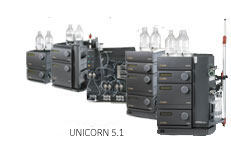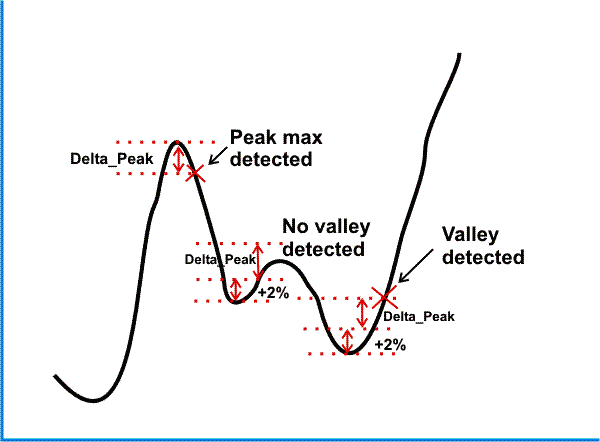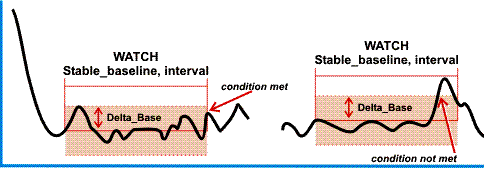

|
|
Standard Watch conditions
|

|
|
Introduction

|
Watch instructions allow the progress
of a method run to be determined by the events during the method
run, for example, start collecting fractions when the first peak
eluates, or equilibrate the column until the eluent conductivity
has reached a given value. This is facilitated by the Watch instructions.
The system strategy includes Watch instructions
for each monitor defined in the system. These instructions are used
to survey method runs, and instruct the system to call a specified
block or an instruction when a particular monitor signal meets a
given condition. As long as the condition is not met, the block
is not activated.
Note:
Watch instructions are shown in
the Instruction box of the Text Instructions editor, indicated
in the Block pane by a green
line that shows the start and duration of the watch.
|
|
|
|
|
When is a Watch active?

|
The breakpoint when the Watch instruction
is issued determines when the watch begins, not when the block is
activated.
A watch is active from the point at which it is issued until
-
the Watch condition is met
or
-
a new watch is
set for the same monitor
or
-
a Watch_Off instruction
is issued for the monitor.
|
|
|
|
|
How to insert a Watch instruction

|
Watch instructions are inserted
in the Instruction box of
the Text Instructions Editor.
The table below describes how to do this.
|
Step
|
Action
|
|
1
|
In the Breakpoint field,
select the appropriate breakpoint. This decides when the watch begins.
|
|
2
|
-
Select Watch in the Instructions field.
-
Select a Watch instruction from
the list.
-
Select appropriate values under Test, Value and Action in the Parameters field.
|
|
3
|
Click the Insert button.
Result: The new Watch instruction is inserted
on the list of actions in the Text window.
|
|
|
|
|
|
Test options in the Parameters field

|
The
table below describes the Watch options
that are available on the Test drop-down
list of the Parameters field:
|
Option
|
Explanation
|
|
Greater_Than
|
The signal exceeds a certain value.
|
|
Less_Than
|
The signal falls below a specified value.
|
|
Slope_Greater_Than
|
The rate of change of the signal exceeds a specified
value, expressed in monitor units/minute (for example, mAU/min).
|
|
Slope_Less_Than
|
The rate of change of the signal falls below a specified
value, expressed in monitor units/minute (for example, mAU/min).
|
|
Less_Than_Or_Valley
|
The signal falls below a specified value or a valley
is detected. A valley is detected only after a Peak_Max has been detected, and
the valley is defined by a local minimum followed by an increase
to 102% of the local minimum value plus the Delta_Peak value
(see below).
|
|
Peak_Max
|
The signal falls to a specified fraction of the most
recent peak maximum minus the Delta_Peak value. Factor=1
detects peak maximum.
|
|
Stable_Baseline
|
The signal is stable within the limits of the Delta_Base value for the period
specified by the minutes parameter.
|
Note: For slope
values, use the Differentiate function
in the Evaluation module
to measure the slope of the test chromatogram. The Simulate Peak Fractionation technique
can also be used to find the slope values.
|
|
|
|
|
Watch conditions for air sensors and AuxIn

|
Two Watch conditions are available
for systems with air sensors, although they may be handled differently
depending on the system. The table below describes the conditions
and their explanations:
|
Condition
|
Explanation
|
|
Equal 0
|
No air detected.
|
|
Equal 1
|
Air detected.
|
Note: To use the Watch_AirSensor instruction for
air sensors, the Alarm_AirSensor setting
must be disabled.
|
|
|
|
|
Actions when a Watch condition is met

|
The table below describes possible actions when a watch condition
is met:
|
Instruction
|
Effect
|
|
Block name
|
Calls the named block.
|
|
Pause, Hold
|
Pauses or holds the method.
|
|
Continue
|
Continues the method if paused or held.
|
|
End_block
|
Ends the current block and return to the point from which
the block was called.
|
|
End_method
|
Ends the method.
|
|
Ready
|
Indicates that the next step in a MethodQueue may start.
|
|
|
|
|
|
How to enter settings for Delta_Peak and Delta_Base

|
Permanent
settings
Permanent settings for Delta_Peak and Delta_Base are entered with the WatchPar instruction (for example WatchPar_UV, WatchPar_Cond) under System:Settings in the System Control module (see the
Administration and Technical Manual).
Temporary
settings
Temporary settings that apply only for the duration of a given
run can be entered in the Instructions field of the Instruction box in the Text Instructions editor. Select Alarms&Mon and then WatchPar.
|
|
|
|
|
The Delta_Peak setting

|
The Delta_Peak setting helps the software
to detect valleys, peaks and peak maximum, and to ignore noise in
the chromatogram.
The Delta_Peak value
should be set
As a general guideline, set the value to 2-3 times the noise
level and 5-10% of the smallest expected peak height. If you set
a too high value you can prevent a new peak from being detected
after a local minimum.
|
|
|
|
|
Use of the Delta_Peak setting

|
The Delta_Peak setting
-
sets the threshold
for signal increase after a local minimum that will be interpreted
as a valley for the Less_Than_Or_Valley condition.
A valley and a new peak are detected when the signal increases to
102% of the local minimum plus the Delta_Peak value.
Note: A valley is
detected only after a Peak_Max has
been detected.
Example:
If there is a local minimum at 0.05 AU and a Delta_Peak of 0.01 AU, a valley
will be detected at:
(1.02 x 0.05)+0.01=0.111 AU
-
sets the threshold for signal decrease after a local
maximum that will activate the Peak_Max condition. Peak_Max is detected when the
signal falls to the specified fraction of the most recent peak maximum
minus the Delta_Peak value.
The figure below illustrates the Delta_Peak setting
where Peak_Max is detected
when the signal falls by Delta_Peak from
a local maximum if the Peak_Max factor is
set to 1:

|
|
|
|
|
The Delta_Base setting

|
The Delta_Base setting helps the software
to determine when the baseline is considered to be stable. In other
words, it defines the permitted variation for the Stable_Baseline condition. For
this condition to be activated, the signal may not vary by more
than the Delta_Base value
up or down over the time interval specified in the Stable_Baseline condition in the Watch instruction.
Note: The Delta_Base setting affects the Stable_Baseline condition only.
|
|
|
|
|
The condition Watch Stable_Baseline

|
The condition Watch Stable_Baseline is met if
the signal does not deviate by more than ąDelta_Base from
the baseline during the time interval specified for the watch. The
baseline value is determined by the signal at the start of the watch.
If the condition is not met, a new interval is started with a new
baseline value defined by the signal level at the start of the new
interval.
The illustration below shows an example of this:

|
|
|
|
2005-06-15
|
|
|